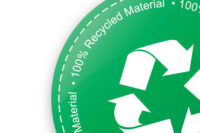2013 U.S. PET container recycling rate hits 31%
Strong end use markets drive growth in domestic PET processing

The National Association for PET Container Resources (NAPCOR, napcor.com) and The Association of Postconsumer Plastic Recyclers (APR, plasticsrecycling.org) announced today the release of the “Report on Postconsumer PET Container Recycling Activity in 2013.” The report cites a 2013 United States recycling rate of 31.2% for polyethylene terephthalate (PET) plastic bottles, up slightly from 2012’s 30.8%.
Communities in the US collected more PET bottles than ever before in 2013—a total of 1,798 million pounds. Total PET used in the production of U.S. bottles in 2013 was also higher at 5,764 million pounds, despite sales declines in some beverage market sectors. These bottles included a record 475 million pounds of recycled PET content.
“Demand for recycled PET continues to grow, with domestic use in bottles, polyester fiber and other applications increasing year-over-year,” says Tom Busard, NAPCOR chairman, chief procurement officer for Plastipak Packaging, Inc., and President of Clean Tech, Plastipak’s recycling affiliate. “Limited recycled PET supply is still a barrier to growth, but PET reclaimers really boosted their operations in 2013, easily absorbing the increase in bottles collected, and pulling back material that had been exported in previous years.”
Clean PET flake produced by domestic PET reclaimers from U.S. bottles totaled 974 million pounds, an increase of 24% over 2012. The amount of recycled PET used across domestic end-use market segments also increased, from 1,312 million pounds in 2012 to 1,513 million pounds in 2013, with significant gains in PET bottle and fiber end uses. Other trends of note include a continued decrease in export volumes, which represented only 26% of total collection volumes in 2013, the lowest volume since 2004 and the lowest by percentage of total collection since 2000.
“Despite very real challenges for PET recyclers due to limited supply and decreasing bale yields, this report shows a maturing, entrepreneurial industry that continues to innovate and find new material sources and process efficiencies,” says Scott Saunders, APR chairman and general manager, KW Plastics Recycling Division. “Notably, domestic recyclers are contributing more than 790 million pounds of material back into US production of new PET packaging; this is a significant demonstration of domestic closed loop manufacturing.”
While the report holds a lot of good news, NAPCOR and APR continue to acknowledge the industry’s ongoing challenges. Collection of PET bottles for recycling continues to lag far behind demand, underutilizing a robust domestic PET recycling infrastructure with more than 2 billion pounds of capacity. Low PET bale yields— a measure of usable PET derived from the recycling process—add significant cost to reclaimer operations and stress the infrastructure. These low yields are due to increasing presence of non-PET materials in PET bales, and the growth of non-recyclable package innovations. The organizations are working to increase both the quality and the quantity of the supply of PET bottles by encouraging improved bale quality, promoting recycling-friendly package design, and fostering greater collection.
Looking for a reprint of this article?
From high-res PDFs to custom plaques, order your copy today!






